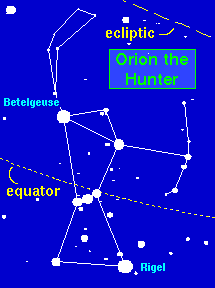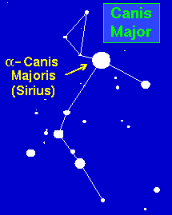Naming the
Stars
The stars on the celestial sphere are named in several different ways. As a
result, the brighter stars may have more than one name. We give a brief
overview of naming stars here.
Common Names
 Most of the brighter stars in the sky have common names that are of historical
and mythological significance. For example, the bright red star in the
shoulder region of the constellation Orion (the Hunter) is called Betelgeuse,
which comes from Arabic and means (roughly) "the armpit of the mighty one"
(see adjacent figure).
The brightest star in Orion is a blue-white star called Rigel that is situated
at the opposite corner of the constellation from Betelgeuse (adjacent figure).
Most of the brighter stars in the sky have common names that are of historical
and mythological significance. For example, the bright red star in the
shoulder region of the constellation Orion (the Hunter) is called Betelgeuse,
which comes from Arabic and means (roughly) "the armpit of the mighty one"
(see adjacent figure).
The brightest star in Orion is a blue-white star called Rigel that is situated
at the opposite corner of the constellation from Betelgeuse (adjacent figure).
As
another example, the brightest star in the constellation Cygnus (the Swan)
is situated near the aft portion of the beast and is called Deneb, which is
also Arabic in origin and means "the tail of the hen".
The Bayer Naming System
 Common names are fine for a few bright stars, but we need a more systematic
method to name all the stars that we see. One
more systematic method is the Bayer system,
which names the brighter stars by assigning a constellation (using the Latin
possessive of the name) and a greek letter
(Alpha, Beta, Gamma, Delta, Epsilon, . . .) in an approximate
order of decreasing brightness
for stars in the constellation. The adjacent figure illustrates for Orion.
Betelgeuse is also called Alpha-Orionis and
Rigel is
called Beta Orionis in the Bayer system.
Common names are fine for a few bright stars, but we need a more systematic
method to name all the stars that we see. One
more systematic method is the Bayer system,
which names the brighter stars by assigning a constellation (using the Latin
possessive of the name) and a greek letter
(Alpha, Beta, Gamma, Delta, Epsilon, . . .) in an approximate
order of decreasing brightness
for stars in the constellation. The adjacent figure illustrates for Orion.
Betelgeuse is also called Alpha-Orionis and
Rigel is
called Beta Orionis in the Bayer system.
The ordering of stars by brightness in the classical Bayer system is only
approximate. For example, Rigel (Beta Orionis) is actually slightly brighter
than Betelgeuse (Alpha Orionis), and Kappa Orionis is considerably
brighter than the position of Kappa in the Greek alphabet would suggest.
 As a final example, the brightest star in the nighttime sky is Sirius,
which is in the constellation Canis Major and is termed Alpha Canis
Majoris in the Bayer naming system. Here is a list of 70 of the
brighter stars, including common names, Bayer names,
positions on the celestial sphere, and
spectral class.
As a final example, the brightest star in the nighttime sky is Sirius,
which is in the constellation Canis Major and is termed Alpha Canis
Majoris in the Bayer naming system. Here is a list of 70 of the
brighter stars, including common names, Bayer names,
positions on the celestial sphere, and
spectral class.
The Flamsteed Naming System
The Bayer system is a little more systematic than a set of common names, but
there are only a finite number of letters in the Greek alphabet, so it cannot
be used easily to name very many stars. The Flamsteed naming system can in
principle be used to name any number of stars. In this system one
uses the same Latin possessive of the constellation name as in the Bayer
system, but the stars are distinguished, not by their brightness, but by their
nearness to the western edge of the constellation by assigning an arabic
numeral. Thus, the closest star to the western edge of the constellation
Cygnus is called 1-Cygni in the Flamsteed system and 61-Cygni
denotes the star that is the 61st closest to the western edge.
Star Catalogs
There are various specialized star catalogs in which stars may be given names
according to some convention.
Such specialized catalogs are of importance in astronomical
research, but we won't discuss them further in our introductory course.
 As a final example, the brightest star in the nighttime sky is Sirius,
which is in the constellation Canis Major and is termed Alpha Canis
Majoris in the Bayer naming system. Here is a list of 70 of the
brighter stars, including common names, Bayer names,
positions on the celestial sphere, and
spectral class.
As a final example, the brightest star in the nighttime sky is Sirius,
which is in the constellation Canis Major and is termed Alpha Canis
Majoris in the Bayer naming system. Here is a list of 70 of the
brighter stars, including common names, Bayer names,
positions on the celestial sphere, and
spectral class.
 Most of the brighter stars in the sky have common names that are of historical
and mythological significance. For example, the bright red star in the
shoulder region of the constellation Orion (the Hunter) is called Betelgeuse,
which comes from Arabic and means (roughly) "the armpit of the mighty one"
(see adjacent figure).
The brightest star in Orion is a blue-white star called Rigel that is situated
at the opposite corner of the constellation from Betelgeuse (adjacent figure).
Most of the brighter stars in the sky have common names that are of historical
and mythological significance. For example, the bright red star in the
shoulder region of the constellation Orion (the Hunter) is called Betelgeuse,
which comes from Arabic and means (roughly) "the armpit of the mighty one"
(see adjacent figure).
The brightest star in Orion is a blue-white star called Rigel that is situated
at the opposite corner of the constellation from Betelgeuse (adjacent figure).  Common names are fine for a few bright stars, but we need a more systematic
method to name all the stars that we see. One
more systematic method is the Bayer system,
which names the brighter stars by assigning a constellation (using the Latin
possessive of the name) and a greek letter
(Alpha, Beta, Gamma, Delta, Epsilon, . . .) in an approximate
order of decreasing brightness
for stars in the constellation. The adjacent figure illustrates for Orion.
Betelgeuse is also called Alpha-Orionis and
Rigel is
called Beta Orionis in the Bayer system.
Common names are fine for a few bright stars, but we need a more systematic
method to name all the stars that we see. One
more systematic method is the Bayer system,
which names the brighter stars by assigning a constellation (using the Latin
possessive of the name) and a greek letter
(Alpha, Beta, Gamma, Delta, Epsilon, . . .) in an approximate
order of decreasing brightness
for stars in the constellation. The adjacent figure illustrates for Orion.
Betelgeuse is also called Alpha-Orionis and
Rigel is
called Beta Orionis in the Bayer system.